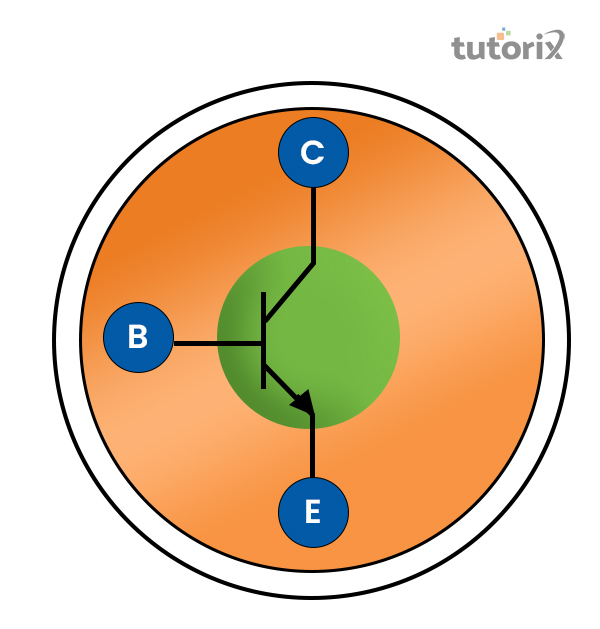

Transistors hold significant importance in day-to-day life. These are the specific and solid electrical devices which allow the smooth current flow within multiple electronic devices These are largely used in a variety of devices like motors, lamps, and many other high voltage types of equipment. These are used in hearing aids, pacemakers, cameras, watches, and calculators. Transistors are used in different devices to maintain the successful conduction flow of electricity. Its uses have made a revolution in current flow.
A transistor is an electrical component which is used in circuits to switch or amplify electrical power or signals. It is widely used in various electrical devices. A transistor possesses two PN diodes which are connected back to back. It has the terminals namely Collector, base, and emitter.

Figure 1: Transistor
Transistors are mainly divided into three categories: Field-effect transistors, bipolar transistors, and insulated-gate bipolar transistors. Bipolar transistor is further divided into two major types- Npn and Pnp transistors. There are multiple differences between Pnp and Npn transistor. The application makes the transistor an amplifier and a device switch.
Npn Transistor −Npn transistor generally possesses two n-type semiconductors which sandwich the p-type semiconductor. In this particular transistor one p type material is situated between two n-type materials (Wu et al. 2018).
Npn transistor enhances the weak signals that enter into the base and generates strong amplify signals at collector end. This element is used to amplify the circuits.

Figure 2: Npn Transistor
Pnp Transistor − Pnp transistor refers to those transistors in which n type material is placed between two p-type materials.
PNP transistor is used to source the electricity that ensures the flow of the electricity out of a collector. Pnp transistors are needed to turn off something phishing a button.

Figure 3: Pnp Transistor
There are several differences that are presented between these two major types of transistors. One of the prominent differences between Npn and Pnp transistors is in NPN transistor, the electrical flow between the collector to the emitter occurs when the positive supply is provided to a base. As opined by Sun et al. (2021), on the other hand, in the case of Pnp transistor negative supply is sent during the charge flow from emitter to collector.
These two types of transistors are very essential in daily life applications. The prominent differences are mentioned below −
| Npn | Pnp |
|---|---|
| Current flows from collector to emitter | Direction of current is emitter to collector |
| The ground signals are generally low in this type of transistor. | High ground signals are produced in these transistors. |
| It carries the atoms which donate the electrons. | It generally carries the atoms which are electron acceptors. |
| Npn transistor acts like 2 NP junction diodes when they are connected back to back with cathode diodes. | These types of transistors act as two PN junction diodes when the output of pnp transistor is connected with the input of another PNP transistor. |
| Npn sensors normally produce output or signals. | Pnp sensors generate the positive output. |
| The small current generally flows from the emitter to the base junction. | Small current commonly flows from Base to the Emitter. |
The importance of transistors in today’s world cannot be avoided. There are numerous kinds of applications for transistors in many electronic materials. Transistors brings the revolution in the field of electricity. It paved a way for cheaper and smaller radios, computers, and calculators. Transistors are generally made by using pure silicon. Transistors are very essential as it used to replace mechanical relays and vacuum tubes (Rodovalho, Aiello & Rodrigues, 2018). The discovery of transistors revolutionizes the field of electricity. The main function of the transistor is to switch of the electric signals as well as to amplify electronic signals. The circulation of the electric current by all types of the transistors are adjusted by the electron addition.
In today’s modern world, transistors have a significant value. In our great life transistors are used in different forms. Transistors are used in multiple oscillators, detectors, and modulators. These transistors are used in computers, and in any kind of circuit to perform various functions. These are also used in to switch the electric signals. Transistors are predominantly used in analog and digital circuits and it acts as a switch. It can also be applied to power controllers and power regulators (Rai, Raitza & Kumar, 2019) Transistors are greatly used in the conduction and regulation of the current flow.
Transistors are one of the essential electronic devices that are used in everyday life to supply power to the different electronic devices. There are a few types of transistors that are used to accomplish various kinds of activities. In multiple electronic equine mats transistors are no doubt an essential art that regulates and mountains the current flow within the devices. Excellent electronic switches can be made by transistors. Pnp transistors as well as Npn transistors are used in different electrical devices to perform various activities.
Q1.What is the most used application of transistors in everyday life?
Cellular phones is the most commonly used applications of the transistors. In phones, the transistor is used for decreasing current consumption.
Q2.How are transistors used in computers?
In digital world, transistors acts like binary switch on a wall. Transistors either allow or prevent electricity to flow within. It is a necessary device that is also used in computers. Computers normally use transistors as the basic mechanism for moving and storing data.
Q3.What are the uses of transistors in the electronic circuits?
Transistors which is a semiconductor devices, are mainly used to control, generate and amplify the electrical signals.
Q4.What is the main function of a transistor?
The transistor refers to the electronic devices device which is predominantly used to regulate the voltage or current flow. It also works as a gate or switch for electrical signals.